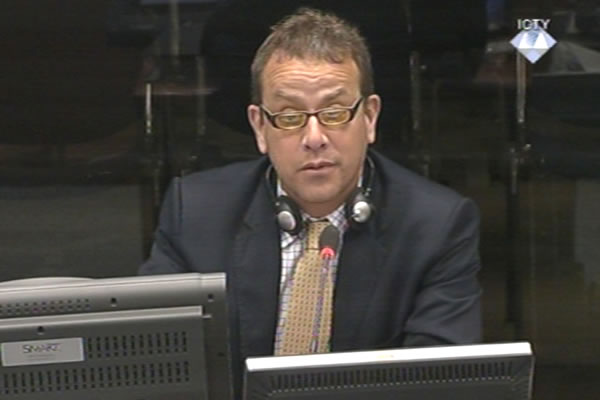Home
FORENSIC EVIDENCE FROM FIRST STAGE OF SREBRENICA INVESTIGATION
Jose Baraybar, a forensic anthropologist from Peru, described the methodology used to establish the age, sex and the minimum number of 2,541 bodies of the Srebrenica Bosniaks exhumed from 1996 to 2001
 Jose Pablo Baraybar, witness at the Ratko Mladic trial
Jose Pablo Baraybar, witness at the Ratko Mladic trial The prosecution case continues at the trial of Ratko Mladic with the evidence of Peruvian forensic anthropologist Jose Pablo Baraybar. From 1996 to 2001, Baraybar was part of the Tribunal’s OTP investigation team involved in the exhumation of the graves containing the remains of the Srebrenica victims in Eastern Bosnia. Nova Kasaba, Konjevic Polje and Glogova were among the sites that were exhumed.
The transcript of Baraybar’s testimony in the case against Radislav Krstic from 2000 was admitted into evidence together with his expert report and several reports on the exhumations carried out at the sites. Baraybar has also given evidence at three more trials in The Hague, including the two trials of former Serbian officials where he testified about the exhumations of mass graves in Serbia containing the remains of the Albanian civilians from Kosovo.
The expert from Peru today stated that by 2001 the remains of at least 2,541 persons had been exhumed from the graves in Eastern Bosnia. This is the minimum figure, a ‘conservative estimate’ based on identifying and counting the same types of bones in a single grave, e.g., left femurs or the first cervical vertebra. Since Baraybar left the OTP investigation team the number has increased significantly and the DNA analysis technology has developed and as a result, 6,849 Srebrenica victims have been exhumed and identified. Former OTP investigator Dusan Janc gave this figure in his recent evidence at Mladic’s trial.
In the cross-examination, defense counsel Miodrag Stojanovic tried to prove that the graves Baraybar exhumed contained not only the bodies of the men from Srebrenica executed in July 1995, but the soldiers killed in combat. The defense claims that the Bosnian Serb army, under the command of the accused, cleared up the terrain after the fighting, collecting and burying the bodies of the BH Army soldiers who were killed in the fighting as they tried to break out of Srebrenica.
The defense counsel put it to the witness that the bodies of soldiers who had been killed in combat were buried in the Nova Kasaba 8 grave. As the defense claimed, there was a road near the grave that was used by the soldiers as they tried to reach Tuzla. Baraybar explained that 33 bodies were recovered from that grave. Willow branches and leaves were also found in the deeper layers of the grave. Baraybar inspected the area around the grave and was able to establish that the only willow tree was at a site known as Nova Kasaba 5. Since bullet casings were found there as well as marks left by a backhoe, Baraybar assumed that the execution took place there and that the bodies were then transferred about 100 meters to the Nova Kasaba 8 mass grave. The witness couldn’t say why the bodies were not buried at the execution site. He assumed that there was an effort to cover up the crime because the execution site was located very close to the road.
The Peruvian forensic anthropologist will complete his evidence tomorrow morning. The US military intelligence analyst Richard Butler is slated to testify next.
Linked Reports
- Case : Mladic
- 2013-08-29 MLADIC WANTS WEDNESDAYS OFF
- 2013-08-29 ‘INSANE’ THEORIES ABOUT CAUSE OF MARKALE EXPLOSION
- 2013-08-28 JUSTIFYING THE SHELLING OF SARAJEVO
- 2013-09-04 MLADIC’S ROLE IN SREBRENICA OPERATION
- 2013-09-05 EVERYTHING WAS UNDER MLADIC’S CONTROL
- 2013-09-06 A BAD ATTEMPT TO COVER UP SREBRENICA MASSACRE
